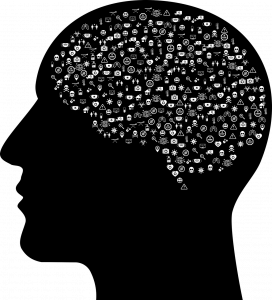The Stigma and the Taboo
The stigma around mental illness is experienced when a person associated with a mental illness is shamed by the people around them, such as their community. It affects sufferers of a given mental illness, and often even extends to their family[Girma]. This stigma gives rise to taboo, in which social pressure discourages discussion, and encourages exclusion. In this way, negative beliefs are socially reinforced. For instance, if a group of people around you, say your friends, believe that people with mental illnesses are dangerous, they might choose to exclude people perceived to be mentally ill from parties, significant life events, or any type of social gathering. If you oppose your group of friends, you run the risk of being excluded yourself. Because of this, you are more likely to adopt these beliefs, as pressure to conform to social groups is very strong.
One of the most universally-known psychological studies on peer pressure, completed by Solomon Asch, found that even if a group of peers (shown above as “stooges”) is full of complete strangers—over 75% of people would agree with statements they knew were objectively wrong, in accordance with the other members of the group[simplypsych on conformity]. When answering questions comparing the lengths of lines on a chalkboard, if a group gave one incorrect answer, at least 3 out of 4 people would agree with that answer, no matter how obviously incorrect it was. Furthermore, participants reported feeling uncomfortable reporting what they knew to be objectively correct answers. Replace the length of lines with a topic such as mental illness, and the strangers with important people in one’s life, one can imagine how easily people become settled in as part of a group with stigmatizing beliefs.
The individual in this situation, who may have had no part in the active alienation of any person, is now a member of a group that has placed a stigma on mental illness. Because of this, over time they will likely come into less contact with those living with a mental illness, are less likely to feel comfortable discussing issues of mental illness, and are more likely to be anxious about even a hypothetical situation in which they encounter mental illness[Manago]. All these factors, over time, make it far more likely that they, themselves, will end up with more negative beliefs about mental illness, even if they originally had no malice toward it. This is just one of many examples of the cycle that perpetuates the stigma around mental illness.
Public Stigma and Self-Stigma
As one might expect, the effects of stigma on mental illness manifest in more ways than just in social settings. In general terms, there are two primary ways that stigma manifests to the detriment of the mentally ill: public stigma, and self-stigma. Public stigma refers to the negative beliefs of the public about mental illness, whereas self-stigma refers to the internalization of those beliefs, and thus the negative beliefs that the mentally ill hold about themselves. Put another way, the effects of self-stigma are a result of people with mental illness believing the negative things they hear, see portrayed, or otherwise experience relating to the topic of mental illness.
Being that the effects of these beliefs are so pervasive, negative perceptions of mental illness can be seen in a number of ways. This gives researchers the ability to identify and measure stigma in a variety of ways. To measure the stigma, some researchers have looked at social factors like isolation or alienation of people with mental illness, the extent to which stereotypes about them are believed, and perception of discrimination[Ritsher]. These are applications of the three most universally recognized consequences of stigma: stereotype, prejudice, and discrimination[Corrigan]. An easy way to understand the relationship of these three terms, is to understand the stereotypes as the negative beliefs themselves, the prejudice as the extent to which people believe the stereotypes, and the prejudice as the behaviors people practice as a result of their prejudice. Yet another way, is to think of the stereotypes and prejudice
as the roots of the stigma, which leads to the formation of taboos, which is one type of discrimination.
What are the negative beliefs about mental illness that lead to stigma?
Some specific negative misconceptions of mental illness have been shown to consistently contribute to the stigmatization of mental illness across cultures[Brockington][Taylor][Haslem]. Labeling of these beliefs varies, but the core of each has been reliably studied. First, is the belief that people with a mental illness are dangerous and unpredictable. In the minds of people who believe this idea, it provides a valid basis for excluding mentally ill individuals. Second, is the belief that the symptoms of the mentally ill are unlikely to improve, and therefore the people who experience them are unreliable. Closely related, is the idea that people with mental illnesses are childlike. People who hold these beliefs often use them as reasoning that people with mental illness are incapable of “knowing what’s best for them”, and so they should have their decisions made by other people. Lastly, is the position that people with mental illness are responsible for their own conditions. People with mental illness then, as the reasoning goes, are to be blamed, even shamed for how their illness presents.
Where do these beliefs come from?

Clearly, harmful media depictions of mental illness provide a dangerous avenue for stigmatizing values to gain popularity. To that end, it is believed by sociologists that those depictions are steadily being removed, as we gain sensitivity to mental illness as a society [Wahl]. In many cases however, these larger negative behaviors towards mental illness are rooted in other, more fundamental misconceptions, some of which the believer may be unaware. For example, reductionism is an issue that often furthers the stigma on mental illness. Generally, reductionism is the oversimplification of an issue, such that it overlooks key aspects. As it relates to mental illness, reductionist thinking often ignores the dynamic nature of mental illness. Mental illness is a result of many environmental, social, and biological factors and their complex interactions.
A study from 2015 investigated the effects of “biogenetic explanations” of mental illness on stigma, which are explanations that deal only with biological or genetic causes of mental illness. A biogenetic understanding might sound something like “people have depression because of a serotonin deficiency”, which ignores circumstances in one’s life that led to their depression. The study found that while biogenetic understandings decreased stigma in some ways, it increased it in others.
This has been dubbed the mixed blessings model, in reference to more scientific explanations of mental illness having both positive and negative effects on stigma. While people who had biogenetic understandings were less likely to blame people for their own mental illness (positive effect on stigma), they were more likely to see people with mental illness as categorically different from others (negative effect on stigma)[Haslem 2015]. Put another way, though people with this mindset realize that mental illness is not something for which a person is responsible for experiencing, they tend to have the misconception that mental illness makes them fundamentally different from others. When you view people as fundamentally different from yourself, you are liable to develop all sorts of negative views about them. In this case, you no longer hold them to the standard of things you would believe about yourself or people to whom you are close.
On the other hand, people who tend to understand mental illness as more affected by the environment (a more psychosocial understanding), are susceptible to view mental illness as being totally dependent on circumstance. When the biological components of mental illness are disregarded entirely, some people may advise those with mental illness just to change their behavior (i.e. “just change your group of friends,” “ just go outside more,” “just do this or that,” etc.), not realizing that some effects of mental illness are outside of one’s control. While indeed changing behavior is a valid approach to some cases of mental illness, this can be alarming to a person who is struggling. Some of their behaviors may actually be protective to their mental health, and telling people that changing them will “cure” their mental illness is often reductive to their experience, as well.
However, these people typically engage in more empathy towards mental illness. Likely, this is because they could imagine themselves in a set of circumstances that would predispose themselves to experience symptoms of mental illness. This brings us to a key difference between these two approaches. Biogenetic understandings tend to lead one to think of people with mental illness as different, part of an out-group. Whereas psychosocial understandings tend to lead one to think of people with mental illness as potential members of an in-group, only having undergone some experience(s) that predisposed them to their mental illness.

An in-group is a one in which a person more easily sees similarities between themselves and the group, believing that they themselves are a member of the group. An out-group then, is one in which a person more easily sees differences between themselves and the group, typically not identifying with the group. The natural tendency of humans to view out-groups as lesser than themselves is problematic in the case of overly biogenetic understandings. In contrast, the tendency to minimize problems of mental illness to one’s behavior (since it is assumed that the in-group is more or less the same as yourself), is problematic in the case of overly psychosocial understandings.
Our models of stigma and taboo, and of stereotype, prejudice, and discrimination demonstrate a seemingly obvious but important point: the way we think about mental illness dictates the ways in which we act towards it. The discussion above shows how overlooking any side of mental illness can lead to stigma. It may seem like a lot to be conscious of in everyday life. Then, how should we think about and act towards mental illness? What is the most optimal and sensitive understanding one could have? How do we reach it?
Starving the Stigma
Strategies in reducing stigma typically center around protest, education, and contact[Corrigan 2]. Remembering that self-stigma largely is the result of the internalization of public stigma, social interactions that lead to stigma seems a great place to start. Of course, changing society’s mindset to mental illness will require attacking the problem from all angles. Though stigma starts with false beliefs, we can enact changes to stigma by changing our behaviors as well. Indeed, one of the most tried and true methods of obtaining an accurate representation of mental illness is perhaps exactly what one would expect: contact. Exposure to real people who suffer from the effects of mental illness is one of the best ways to normalize it. Coming into contact with people who suffer from mental illness is one of the best ways to decrease prejudice[Svensson][Pescosolido]. It can be difficult however, to ensure that people do interact with others who suffer from mental illness.
Since one can’t necessarily dictate who people associate with, education and protest are great candidates for changing the root beliefs of stigma. They become even more attractive options given that cognitive-dissonance theory shows us that people are much more likely to change their behaviors according to their beliefs, than the other way around[Harmon-Jones]. A study from January of 2022 shows that even changing the perception of beliefs (not even the beliefs themselves), can lead to huge cultural changes in how we treat mental illness. The study implemented an extensive anti-stigma campaign at a large university. They found that if enough people just heard the message, their perception of the cultural norms (social/ cultural rules) would change. This perception alone led to significant increases in contact, decreases in avoidance, and a decrease in anxiety between different groups[Manago].
To fully understand the importance of these results, remember, this is just the result of hearing the message. Imagine the change in attitudes of the people who agreed with the message, those who were meaningfully persuaded. The reason that just hearing the message had so many profound effects might be unexpected, but makes a lot of sense if we remember what we learned about conformity from the beginning. Social pressure, or “peer pressure” as it is often called, is a huge motivator for changing values. If a point is voiced loudly enough and frequently enough, people will start to agree based solely on the perception that others agree. This is one of the many reasons why advocacy is so crucial for marginalized groups. Convincing certain people of progressive values may well-be an uphill battle. Convincing them that they ought to, at the very least, accept them for social preservation however, is as sure a process as any. Furthermore, people are increasingly more likely to be convinced by the content of an argument once they know that the idea is accepted by those that are close to them.
The Bottom-Line

Mental illness is a dynamic experience that is very responsive to the culture and environment. If it seems like there are a lot of things to be aware of in your everyday life, know that you need not be able to identify everything feeding into the expression of a person’s mental illness. There are countless factors that have led to a person feeling the way they do. You won’t know them all, you can’t know them all, and that’s okay. Thinking and acting more positively towards the mentally ill will not only better their experiences, but could help to address some factors that exacerbate it as well. At the end of the day, the golden rule is golden for a reason. Treat others how you would have them treat you. If you focus on the ways that others are similar to yourself, you are well on the right track.
~ Gabe Sweezy

Gabe Sweezy is an undergraduate student of neuroscience and a premedical student at Saint Louis University. As a student of cognitive neuroscience with a passion for mental health, Gabe is particularly interested in the biological processes underlying mental illnesses.
This research article is supervised and sponsored by Faculty Sponsor, Dr. Brenda Kirchhoff Ph.D
Sources:
Harmon-Jones, E., & Mills, J. (2019). An introduction to cognitive dissonance theory and an overview of current perspectives on the theory. Cognitive Dissonance: Reexamining a Pivotal Theory in Psychology (2nd Ed.)., 3–24. https://doi.org/10.1037/0000135-001
Ritsher JB, Otilingam PG, Grajales M. Internalized stigma of mental illness: psychometric properties of a new measure. Psychiatry Res. 2003 Nov 1;121(1):31-49. doi: 10.1016/j.psychres.2003.08.008. PMID: 14572622.
Girma, E., Möller-Leimkühler, A. M., Müller, N., Dehning, S., Froeschl, G., & Tesfaye, M. (2014). Public stigma against family members of people with mental illness: findings from the Gilgel Gibe Field Research Center (GGFRC), Southwest Ethiopia. BMC International Health & Human Rights, 14(1), 1–15. https://doi-org.ezp.slu.edu/10.1186/1472-698X-14-2
Haslam, N., & Kvaale, E. P. (2015). Biogenetic Explanations of Mental Disorder: The Mixed-Blessings Model. Current Directions in Psychological Science, 24(5), 399–404. https://doi.org/10.1177/0963721415588082
Corrigan, P. W., & Watson, A. C. (2002). Understanding the impact of stigma on people with mental illness. World psychiatry : official journal of the World Psychiatric Association (WPA), 1(1), 16–20.
Manago, B., & Krendl, A. C. (2022). Cultivating contact: How social norms can reduce mental illness stigma in college populations. Stigma and Health. Advance online publication. https://doi.org/10.1037/sah0000363
Wahl OF. Media madness: public images of mental illness. New Brunswick: Rutgers University Press; 1995.
https://www.simplypsychology.org/asch-conformity.html
https://www.simplypsychology.org/cognitive-dissonance.html
Brockington I. Hall P. Levings J, et al. The community’s tolerance of the mentally ill. Br J Psychiatry. 1993;162:93–99.
Taylor SM. Dear MJ. Scaling community attitudes toward the mentally ill. Schizophr Bull. 1980;7:225–240.
Svensson, B., & Hansson, L. (2016). How mental health literacy and experience of mental illness relate to stigmatizing attitudes and social distance towards people with depression or psychosis: A cross-sectional study. Nordic Journal of Psychiatry, 70 (4), 309–313.
https://doi.org/10.3109/08039488.2015.1109140
Pescosolido, B. A. (2013). The public stigma of mental illness: What do we think; what do we know; what can we prove?. Journal of Health and Social Behavior, 54 (1), 1–21.
https://doi.org/10.1177/0022146512471197
Corrigan PW. Penn DL. Lessons from social psychology on discrediting psychiatric stigma. Am Psychol. 1999;54:765–776.

